Changxu Cheng
ALTo: Adaptive-Length Tokenizer for Autoregressive Mask Generation
May 22, 2025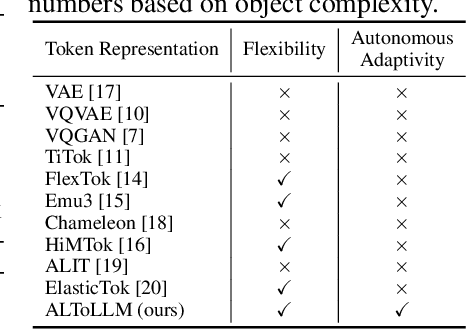
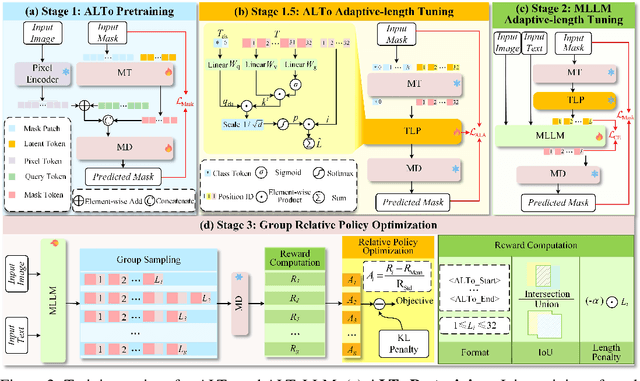
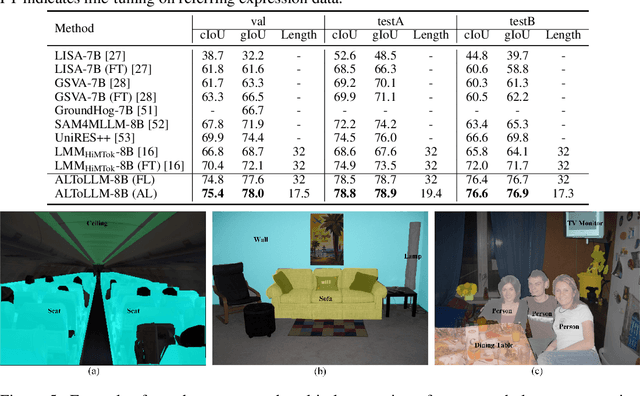
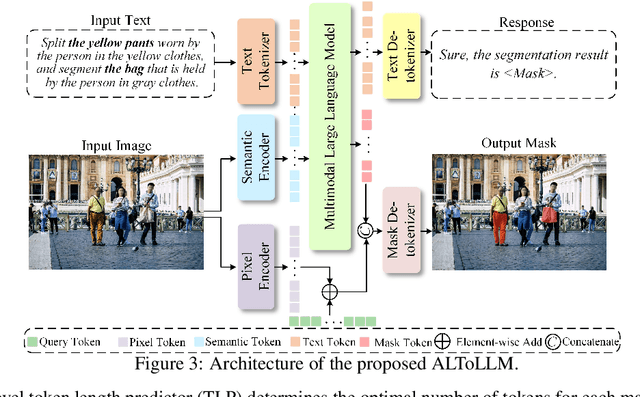
Abstract:While humans effortlessly draw visual objects and shapes by adaptively allocating attention based on their complexity, existing multimodal large language models (MLLMs) remain constrained by rigid token representations. Bridging this gap, we propose ALTo, an adaptive length tokenizer for autoregressive mask generation. To achieve this, a novel token length predictor is designed, along with a length regularization term and a differentiable token chunking strategy. We further build ALToLLM that seamlessly integrates ALTo into MLLM. Preferences on the trade-offs between mask quality and efficiency is implemented by group relative policy optimization (GRPO). Experiments demonstrate that ALToLLM achieves state-of-the-art performance with adaptive token cost on popular segmentation benchmarks. Code and models are released at https://github.com/yayafengzi/ALToLLM.
HiMTok: Learning Hierarchical Mask Tokens for Image Segmentation with Large Multimodal Model
Mar 17, 2025Abstract:The remarkable performance of large multimodal models (LMMs) has attracted significant interest from the image segmentation community. To align with the next-token-prediction paradigm, current LMM-driven segmentation methods either use object boundary points to represent masks or introduce special segmentation tokens, whose hidden states are decoded by a segmentation model requiring the original image as input. However, these approaches often suffer from inadequate mask representation and complex architectures, limiting the potential of LMMs. In this work, we propose the Hierarchical Mask Tokenizer (HiMTok), which represents segmentation masks with up to 32 tokens and eliminates the need for the original image during mask de-tokenization. HiMTok allows for compact and coarse-to-fine mask representations, aligning well with the LLM next-token-prediction paradigm and facilitating the direct acquisition of segmentation capabilities. We develop a 3-stage training recipe for progressive learning of segmentation and visual capabilities, featuring a hierarchical mask loss for effective coarse-to-fine learning. Additionally, we enable bidirectional information flow, allowing conversion between bounding boxes and mask tokens to fully leverage multi-task training potential. Extensive experiments demonstrate that our method achieves state-of-the-art performance across various segmentation tasks,while also enhancing visual grounding and maintaining overall visual understanding.
LISTER: Neighbor Decoding for Length-Insensitive Scene Text Recognition
Aug 24, 2023



Abstract:The diversity in length constitutes a significant characteristic of text. Due to the long-tail distribution of text lengths, most existing methods for scene text recognition (STR) only work well on short or seen-length text, lacking the capability of recognizing longer text or performing length extrapolation. This is a crucial issue, since the lengths of the text to be recognized are usually not given in advance in real-world applications, but it has not been adequately investigated in previous works. Therefore, we propose in this paper a method called Length-Insensitive Scene TExt Recognizer (LISTER), which remedies the limitation regarding the robustness to various text lengths. Specifically, a Neighbor Decoder is proposed to obtain accurate character attention maps with the assistance of a novel neighbor matrix regardless of the text lengths. Besides, a Feature Enhancement Module is devised to model the long-range dependency with low computation cost, which is able to perform iterations with the neighbor decoder to enhance the feature map progressively. To the best of our knowledge, we are the first to achieve effective length-insensitive scene text recognition. Extensive experiments demonstrate that the proposed LISTER algorithm exhibits obvious superiority on long text recognition and the ability for length extrapolation, while comparing favourably with the previous state-of-the-art methods on standard benchmarks for STR (mainly short text).
GeoLayoutLM: Geometric Pre-training for Visual Information Extraction
Apr 21, 2023



Abstract:Visual information extraction (VIE) plays an important role in Document Intelligence. Generally, it is divided into two tasks: semantic entity recognition (SER) and relation extraction (RE). Recently, pre-trained models for documents have achieved substantial progress in VIE, particularly in SER. However, most of the existing models learn the geometric representation in an implicit way, which has been found insufficient for the RE task since geometric information is especially crucial for RE. Moreover, we reveal another factor that limits the performance of RE lies in the objective gap between the pre-training phase and the fine-tuning phase for RE. To tackle these issues, we propose in this paper a multi-modal framework, named GeoLayoutLM, for VIE. GeoLayoutLM explicitly models the geometric relations in pre-training, which we call geometric pre-training. Geometric pre-training is achieved by three specially designed geometry-related pre-training tasks. Additionally, novel relation heads, which are pre-trained by the geometric pre-training tasks and fine-tuned for RE, are elaborately designed to enrich and enhance the feature representation. According to extensive experiments on standard VIE benchmarks, GeoLayoutLM achieves highly competitive scores in the SER task and significantly outperforms the previous state-of-the-arts for RE (\eg, the F1 score of RE on FUNSD is boosted from 80.35\% to 89.45\%). The code and models are publicly available at https://github.com/AlibabaResearch/AdvancedLiterateMachinery/tree/main/DocumentUnderstanding/GeoLayoutLM
Decoupling Visual-Semantic Feature Learning for Robust Scene Text Recognition
Nov 24, 2021
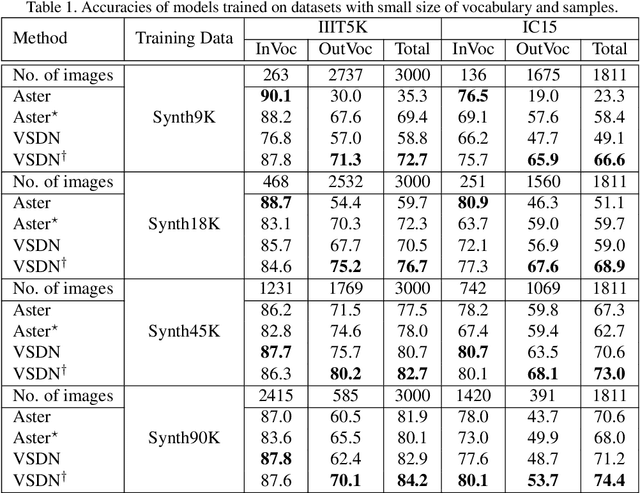
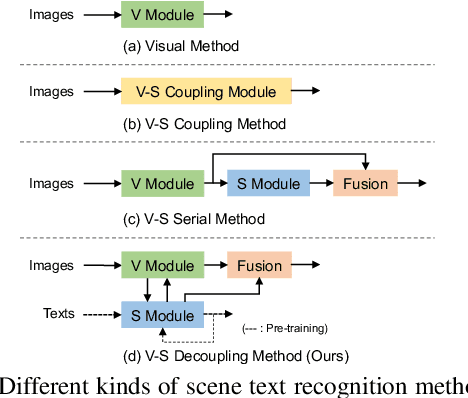

Abstract:Semantic information has been proved effective in scene text recognition. Most existing methods tend to couple both visual and semantic information in an attention-based decoder. As a result, the learning of semantic features is prone to have a bias on the limited vocabulary of the training set, which is called vocabulary reliance. In this paper, we propose a novel Visual-Semantic Decoupling Network (VSDN) to address the problem. Our VSDN contains a Visual Decoder (VD) and a Semantic Decoder (SD) to learn purer visual and semantic feature representation respectively. Besides, a Semantic Encoder (SE) is designed to match SD, which can be pre-trained together by additional inexpensive large vocabulary via a simple word correction task. Thus the semantic feature is more unbiased and precise to guide the visual feature alignment and enrich the final character representation. Experiments show that our method achieves state-of-the-art or competitive results on the standard benchmarks, and outperforms the popular baseline by a large margin under circumstances where the training set has a small size of vocabulary.
Maximum Entropy Regularization and Chinese Text Recognition
Jul 09, 2020



Abstract:Chinese text recognition is more challenging than Latin text due to the large amount of fine-grained Chinese characters and the great imbalance over classes, which causes a serious overfitting problem. We propose to apply Maximum Entropy Regularization to regularize the training process, which is to simply add a negative entropy term to the canonical cross-entropy loss without any additional parameters and modification of a model. We theoretically give the convergence probability distribution and analyze how the regularization influence the learning process. Experiments on Chinese character recognition, Chinese text line recognition and fine-grained image classification achieve consistent improvement, proving that the regularization is beneficial to generalization and robustness of a recognition model.
Patch Aggregator for Scene Text Script Identification
Dec 09, 2019



Abstract:Script identification in the wild is of great importance in a multi-lingual robust-reading system. The scripts deriving from the same language family share a large set of characters, which makes script identification a fine-grained classification problem. Most existing methods make efforts to learn a single representation that combines the local features by making a weighted average or other clustering methods, which may reduce the discriminatory power of some important parts in each script for the interference of redundant features. In this paper, we present a novel module named Patch Aggregator (PA), which learns a more discriminative representation for script identification by taking into account the prediction scores of local patches. Specifically, we design a CNN-based method consisting of a standard CNN classifier and a PA module. Experiments demonstrate that the proposed PA module brings significant performance improvements over the baseline CNN model, achieving the state-of-the-art results on three benchmark datasets for script identification: SIW-13, CVSI 2015 and RRC-MLT 2017.
 Add to Chrome
Add to Chrome Add to Firefox
Add to Firefox Add to Edge
Add to Edge